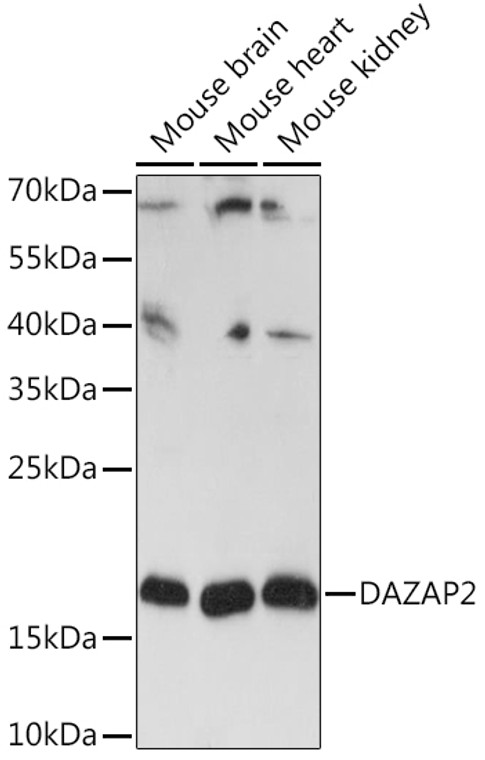| Host: |
Rabbit |
| Applications: |
WB |
| Reactivity: |
Mouse |
| Note: |
STRICTLY FOR FURTHER SCIENTIFIC RESEARCH USE ONLY (RUO). MUST NOT TO BE USED IN DIAGNOSTIC OR THERAPEUTIC APPLICATIONS. |
| Short Description: |
Rabbit polyclonal antibody anti-DAZAP2 (1-168) is suitable for use in Western Blot research applications. |
| Clonality: |
Polyclonal |
| Conjugation: |
Unconjugated |
| Isotype: |
IgG |
| Formulation: |
PBS with 0.01% Thimerosal, 50% Glycerol, pH7.3. |
| Purification: |
Affinity purification |
| Dilution Range: |
WB 1:500-1:2000 |
| Storage Instruction: |
Store at-20°C for up to 1 year from the date of receipt, and avoid repeat freeze-thaw cycles. |
| Gene Symbol: |
DAZAP2 |
| Gene ID: |
9802 |
| Uniprot ID: |
DAZP2_HUMAN |
| Immunogen Region: |
1-168 |
| Immunogen: |
Recombinant fusion protein containing a sequence corresponding to amino acids 1-168 of human DAZAP2 (NP_055579.1). |
| Immunogen Sequence: |
MNSKGQYPTQPTYPVQPPGN PVYPQTLHLPQAPPYTDAPP AYSELYRPSFVHPGAATVPT MSAAFPGASLYLPMAQSVAV GPLGSTIPMAYYPVGPIYPP GSTVLVEGGYDAGARFGAGA TAGNIPPPPPGCPPNAAQLA VMQGANVLVTQRKGNFFMGG SDGGYTIW |
| Tissue Specificity | Widely expressed. Expressed in spleen, thymus, prostate, testis, ovary, small intestine, colon and leukocytes. Down-regulated in multiple myeloma. |
| Post Translational Modifications | Ubiquitinated. Ubiquitinated by SMURF2, leading to proteasomal degradation. Ubiquitinated by NEDD4, leading to proteasomal degradation. Following DNA damage, phosphorylated by HIPK2 which promotes DAZAP2 localization to the nucleus, reduces interaction of DAZAP2 with HIPK2 and SIAH1, and prevents DAZAP2-dependent ubiquitination of HIPK2 by E3 ubiquitin-protein ligase SIAH1 and subsequent HIPK2 proteasomal degradation. |
| Function | In unstressed cells, promotes SIAH1-mediated polyubiquitination and degradation of the serine/threonine-protein kinase HIPK2, probably by acting as a loading factor that potentiates complex formation between HIPK2 and ubiquitin ligase SIAH1. In response to DNA damage, localizes to the nucleus following phosphorylation by HIPK2 and modulates the expression of a subset of TP53/p53 target genes by binding to TP53 at target gene promoters. This limits the expression of a number of cell death-mediating TP53 target genes, reducing DNA damage-induced cell death. Enhances the binding of transcription factor TCF7L2/TCF4, a Wnt signaling pathway effector, to the promoters of target genes. Plays a role in stress granule formation. |
| Protein Name | Daz-Associated Protein 2Deleted In Azoospermia-Associated Protein 2Proline-Rich Transcript In Brain Protein |
| Cellular Localisation | CytoplasmNucleusNucleus SpeckleNuclear BodyStress GranulePredominantly Nuclear In MacrophagesStimulation Of Il17rb With Its Ligand Il17e Induces Accumulation In The CytoplasmPredominantly Cytoplasmic When Unphosphorylated And Localizes To The Nucleus Following Phosphorylation By Hipk2Localizes To Stress Granules Under Cellular Stress Conditions |
| Alternative Antibody Names | Anti-Daz-Associated Protein 2 antibodyAnti-Deleted In Azoospermia-Associated Protein 2 antibodyAnti-Proline-Rich Transcript In Brain Protein antibodyAnti-DAZAP2 antibodyAnti-KIAA0058 antibodyAnti-PRTB antibody |
Information sourced from Uniprot.org
12 months for antibodies. 6 months for ELISA Kits. Please see website T&Cs for further guidance







